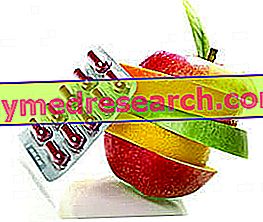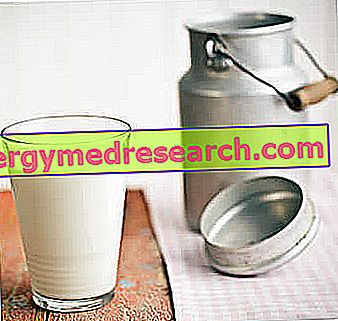Vitamin B1 

Vitamin B1 is a water-soluble vitamin; its scientific name is Thiamine and has several basic metabolic functions.
Vitamin B1 is also known as aneurine, due to its importance in maintaining nervous efficiency, or antiberiberica, by virtue of the typical clinical signs attributable to its nutritional deficiency: the Beri-Beri malnutrition syndrome.
Functions
Metabolic functions:- It is a coenzyme of carbohydrate metabolism
- Influences nerve impulse transmission
- Intervenes in the metabolism of ethyl alcohol.
Absorption and Shortage
Vitamin B1 is absorbed in the duodenum / tenuous and is subsequently deposited in the liver; as anticipated, the nutritional deficiency of thiamine causes Beri-Beri and other neurological complications (neuritis and polyneuritis), while excessive doses (achieved with pharmacological administrations) can induce shock .
Food supply
Food sources of vitamin B1 are essentially vegetable and fungal: whole grains (except refined ones), legumes, wheat germ and fungi in general; it is also present in the liver and molluscs.
Vitamin B1 is quite stable to heat (thermostable) but a certain percentage (variable between foods) ALWAYS is damaged by cooking food; thiamine is also resistant to oxidation and light, while it is negatively exposed to alkaline pH and some preservative agents (SULPHITES).
They are vitamin B1 anti- vitamins: oxytiamine, juritiamine and thiaminase (enzyme of some aquatic animals and bacteria that hydrolyse vitamin B1).
The recommended intake levels are equal to 0.4mg * 1000kcal introduced, but in the adult who introduces less than 2000kcal / day it is NOT advisable to go below 0.8mg / day.
Alcohol damage
Ethyl alcohol is contained in fermented, distilled and liqueur alcoholic beverages. It is a molecule obtained by anaerobic fermentation of sugars through the action of some yeasts called saccharomycetes. Alcohol provides about 7 kcal / g but the human body does not oxidize it effectively and most of that ingested with alcoholic beverages is destined to be converted into fatty acids and deposited in adipose tissue in the form of triglycerides.
Ethyl alcohol has a negative impact on the body ; it is perceived in a toxic way by all the cells of the body (starting from the nervous tissue up to the epithelial one) and alters the hormonal structure promoting the insulin response and inhibiting the secretion of hyperglycemic hormones (it also limits the neoglucogenesis in the liver at enzyme level) .
Ethyl alcohol is a substance that interacts with nerve cells, causing intoxication at the expense of mental lucidity; in virù of this characteristic it is considered a NERVINO principle and, as for opiates or other drugs, it is a molecule that can generate drug addiction.
Ethyl alcohol abuse is defined as ALCOHOLISM; this syndrome of abuse (frequently compulsive) significantly compromises the health status of the subject and is often associated with malnutrition and other complications (such as marasmus and organ degeneration), alterations of the hydro-saline balance and IPOvitaminosis.
The vitamin most involved in alcohol metabolism and lacking in alcoholics is B1.
Thiamine and Alcoholism
Chronic ethanol abuse (alcoholism) produces a vitamin B1 deficiency that triggers Wernicke 's Encephalopathy ; this disorder is acute and manifests as: ophthalmoplegia (extrinsic or intrinsic paralysis of the eyeball), ataxia (loss of muscle coordination), gait disturbances and confusion. The relative complications are mainly of degenerative nervous and vascular type.
The correlation between alcoholism and Wernicke's Encephalopathy concerns several aspects of vitamin B1; in the first place, alcoholism leads to lack of appetite and consequent general malnutrition. As we have already seen, vitamin B1 is present in many foods but above all in whole grains, wheat germ and legumes; it is clear that these are NOT readily available foods for an alcoholic who, for the most part, uses occasional, fortuitous and therefore low quality products. Furthermore, B1 (as opposed to other molecules of the same family) is NOT a vitamin easily storable in the liver (even if normally present in hepatocytes); this means that the organism does not have the possibility to manage the reserves, consequently it can meet IPOvitaminosi. What's more, vitamin B1 shows a very strong sensitivity to some additives, sulphites, which are preservative agents useful to prevent oxidation of foodstuffs. They are sulphites: sulfur dioxide, potassium bisulfite and sodium bisulfite, all used in the preparation of wine (an object of abuse in alcoholism) or in that of dehydrated fruta. It should also be remembered that alcoholism causes chronic intestinal malabsorption which, linked to the above, leads to an almost inevitable lack of vitamin B1 in subjects suffering from chronic alcoholism.
Moreover...
For the alcoholic, vitamin B1 is even more important than the healthy subject; in hepatocytes, it is directly involved in the processes of metabolization and alcohol disposal; not surprisingly, in the clinic, to reduce alcohol levels in acute episodes, injections of up to 300-600mg / day of vitamin B1 or insulin are used (which, despite having the ability to accelerate alcohol disposal up to 25% ethyl, it has too many side effects to be used in massive doses). During detoxification, the use of metadoxine is useful (which favors the release of GABA as a glutamate antagonist, a molecule perhaps responsible for the manifestations of alcohol withdrawal).
Wernicke's Encephalopathy therapy consists of intravenous injections (up to 100mg) of vitamin B1 for several days, further reinforced by oral intakes of about 50mg.
Bibliography:
- Acute inotsications: poisons, drugs and drugs - KR Olson, TD Puppa, M. Ballestrierio - Springer - pag 171
- Complete treatise on abuses and addictions - U. Nizzoli, M. Pissacroia - Piccin - pag 989; 1265.



